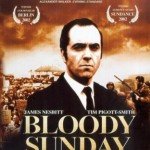 Bloody Sunday is an Irish film, directed by Paul Greengrass and released in 2002. It stars James Nesbitt as Ivan Cooper, Tim Pigott-Smith as Major General Robert Ford, Gerard McSorley as Royal Ulster Constabulary (RUC) Chief Superintendent Frank Lagan and Mary Moulds as Bernadette Devlin. As the title suggests, Bloody Sunday depicts the events of January 30th 1972, culminating in the fatal shooting of 14 civilians in Derry. The film was officially released in the week leading up to the 30th anniversary of the shootings. Its screenplay was inspired by Don Mullan, a Derry-born writer. Mullan’s 1997 book Eyewitness Bloody Sunday contained first-hand accounts of the shootings. Mullan worked as a script consultant on Bloody Sunday and he appears briefly in the film as a Catholic priest.
Bloody Sunday is an Irish film, directed by Paul Greengrass and released in 2002. It stars James Nesbitt as Ivan Cooper, Tim Pigott-Smith as Major General Robert Ford, Gerard McSorley as Royal Ulster Constabulary (RUC) Chief Superintendent Frank Lagan and Mary Moulds as Bernadette Devlin. As the title suggests, Bloody Sunday depicts the events of January 30th 1972, culminating in the fatal shooting of 14 civilians in Derry. The film was officially released in the week leading up to the 30th anniversary of the shootings. Its screenplay was inspired by Don Mullan, a Derry-born writer. Mullan’s 1997 book Eyewitness Bloody Sunday contained first-hand accounts of the shootings. Mullan worked as a script consultant on Bloody Sunday and he appears briefly in the film as a Catholic priest.
Bloody Sunday depicts these events through the eyes of Ivan Cooper. Raised in a Protestant family in the Bogside, Cooper joined the Labour Party and became a moderate Nationalist. He was active in non-violent, non-sectarian political movements, joining the Northern Ireland Civil Rights Association (NICRA) and the Londonderry Citizens’ Action Committee. In the film, Cooper is a leading organiser of the anti-internment march through Derry on January 30th. The march has been banned by the government but Cooper, confident that it will be peaceful, defies the directive. Cooper distributes leaflets and urges participants to refrain from violence, as young people leave their homes and prepare to march. Meanwhile, British soldiers are shown setting up barricades and armed posts in the streets of Derry. After losing several soldiers to Provisional IRA snipers, British commanders appear keen to use a strong hand against protestors. Sensing a dangerous confrontation, RUC commander Frank Lagan suggests the marchers be allowed to proceed along their chosen route. Violence begins when a small group of protestors break away from the main march and begin hurling rocks at soldiers. As the situation unfolds and communication breaks down, British paratroopers are sent into the area, with disastrous results.
The perspective of Bloody Sunday is very clear. It lays blame for the January 30th shootings almost entirely at the feet of the British. March organisers and the vast majority of marchers are depicted as peaceful and non-violent. British commanders, particularly Major General Robert Ford, appear wired for confrontation and eager to assert themselves with armed force. British soldiers, thrown into a tumultuous situation, retaliate to rock-throwing with deadly gunfire. As the situation becomes more chaotic, innocent bystanders and those seeking to help the wounded are also shot. There is little shown to justify the British response, aside from one Republican firing a pistol from a doorway. The Provisional IRA does not escape criticism either: its leaders appear more concerned with exploiting Bloody Sunday’s propaganda value than with its victims.
In sum, Bloody Sunday is a powerful film that captures the chaos and emotion of January 30th 1972. Some have rightly questioned its one-sidedness, arguing that the IRA was more involved in firing on British soldiers than the film suggests. The release of the Saville Report in 2010, however, has affirmed the film’s general perspective. Many critics now consider Bloody Sunday the best cinematic depiction of the Troubles in Northern Ireland.
© Alpha History 2017. Content on this page may not be republished or distributed without permission. For more information please refer to our Terms of Use.
This page was written by Jennifer Llewellyn and Steve Thompson. To reference this page, use the following citation:
J. Llewellyn and S. Thompson, “Bloody Sunday (2002)”, Alpha History, accessed [today’s date], https://alphahistory.com/northernireland/bloody-sunday-2002/.
